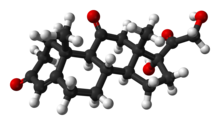Cortisone

| |

| |
| Names | |
|---|---|
| Pronunciation | /ˈkɔːrtɪsoʊn/, /ˈkɔːrtɪzoʊn/ |
| IUPAC name
17α,21-Dihydroxypregn-4-ene-3,11,20-trione
| |
| Systematic IUPAC name
(1R,3aS,3bS,9aR,9bS,11aS)-1-Hydroxy-1-(hydroxyacetyl)-9a,11a-dimethyl-2,3,3a,3b,4,5,8,9,9a,9b,11,11a-dodecahydro-7H-cyclopenta[a]phenanthrene-7,10(1H)-dione | |
| Other names
17α,21-Dihydroxy-11-ketoprogesterone; 17α-Hydroxy-11-dehydrocorticosterone
| |
| Identifiers | |
3D model (
JSmol ) |
|
| ChEBI | |
| ChEMBL | |
| ChemSpider | |
ECHA InfoCard
|
100.000.149 |
IUPHAR/BPS |
|
| KEGG | |
| MeSH | Cortisone |
PubChem CID
|
|
| UNII | |
CompTox Dashboard (EPA)
|
|
| |
| |
| Properties | |
| C21H28O5 | |
| Molar mass | 360.450 g·mol−1 |
| Melting point | 220 to 224 °C (428 to 435 °F; 493 to 497 K) |
| Pharmacology | |
| H02AB10 (WHO) S01BA03 (WHO) | |
Except where otherwise noted, data are given for materials in their standard state (at 25 °C [77 °F], 100 kPa).
| |
Cortisone is a
The term "cortisone" is frequently misused to mean either any corticosteroid or hydrocortisone, which is in fact cortisol. Many who speak of receiving a "cortisone shot" or taking "cortisone" are more likely receiving hydrocortisone or one of many other, much more potent synthetic corticosteroids.
Cortisone can be administered as a prodrug, meaning it has to be converted by the body (specifically the liver, converting it into cortisol) after administration to be effective. It is used to treat a variety of ailments and can be administered
Effects and uses
Cortisone itself is inactive.
A cortisone injection may provide short-term pain relief and may reduce the swelling from
Cortisone is used by
Side effects
Oral use of cortisone has a number of potential systemic adverse effects, including
History
Cortisone was first identified by the American chemists Edward Calvin Kendall and Harold L. Mason while researching at the Mayo Clinic.[10][11][12] During the discovery process, cortisone was known as compound E (while cortisol was known as compound F).
In 1949,
Cortisone was first produced commercially by
Production
Cortisone is one of several end-products of a process called
Because cortisone must be converted to cortisol before being active as a glucocorticoid, its activity is less than simply administering cortisol directly (80–90%).[19]
Popular culture
Addiction to cortisone was the subject of the 1956 motion picture Bigger Than Life, produced by and starring James Mason. Though it was a box-office flop upon its initial release,[20] many modern critics hail the film as a masterpiece and brilliant indictment of contemporary attitudes toward mental illness and addiction.[21] In 1963, Jean-Luc Godard named it one of the ten greatest American sound films ever made.[22]
John F. Kennedy was regularly administered corticosteroids such as cortisone as a treatment for Addison's disease.[23]
See also
 Biology portal
Biology portal Medicine portal
Medicine portal- Central serous retinopathy
- Corticosterol
Notes
- ^ a b c "Cortisone shots". MayoClinic.com. 2010-11-16. Retrieved July 31, 2013.
- ^ a b "Prednisone and other corticosteroids: Balance the risks and benefits". MayoClinic.com. 2010-06-05. Retrieved 2017-12-21.
- ISBN 978-0853693000.
- ^ PMID 19837912.
- ^ "injections and needles for coccyx pain". www.coccyx.org.
- PMID 1582609.
- ^ "All About Atopic Dermatitis". National Eczema Association. Archived from the original on 2012-01-30. Retrieved 2013-05-07.
- PMID 13182965.
- S2CID 18658724.
- ^ "Cortisone Discovery and the Nobel Prize". Mayo Clinic. Retrieved 2009-07-04.
- ^ a b c "I Went to See the Elephant" autobiography of Dwight J. Ingle, published by Vantage Press (1963), pg 94, 109
- . Retrieved 2014-09-07.
- ^ ISBN 978-0-7817-6879-5.
- ^ "The Nobel Prize in Physiology or Medicine 1950". The Nobel Prize. The Nobel Foundation. 2021. Retrieved 2 April 2021.
- PMID 10070369.
- PMID 13875857.
- ^ Gibbons, Ray (1949). "Science gets synthetic key to rare drug; discovery is made in Chicago". Chicago Tribune. Chicago. p. 1.
- PMID 16337555.
- ^ "Corticosteroid Dose Equivalents". Medscape. Retrieved 20 December 2016.
- ^ Cossar 2011, p. 273.
- ^ Halliwell 2013, pp. 159–162.
- ^ Marshall, Colin (December 2, 2013). "A Young Jean-Luc Godard Picks the 10 Best American Films Ever Made (1963)". Open Culture.
- ^ Altman, Lawrence (October 6, 1992). "The doctor's world; Disturbing Issue of Kennedy's Secret Illness". The New York Times.
Bibliography
- Bonagura J., DVM; et al. (2000). Current Veterinary Therapy. Vol. 13. pp. 321–381.
- Cossar, Harper (2011). Letterboxed: The Evolution of Widescreen Cinema. ISBN 978-0-813-12651-7.
- Halliwell, Martin (2013). Therapeutic Revolutions: Medicine, Psychiatry, and American Culture, 1945-1970. ISBN 978-0-813-56066-3.
- Ingle DJ (October 1950). "The biologic properties of cortisone: a review". J. Clin. Endocrinol. Metab. 10 (10): 1312–54. PMID 14794756.[permanent dead link]
- Woodward R. B.; Sondheimer F.; Taub D. (1951). "The Total Synthesis of Cortisone". Journal of the American Chemical Society. 73 (8): 4057. .
